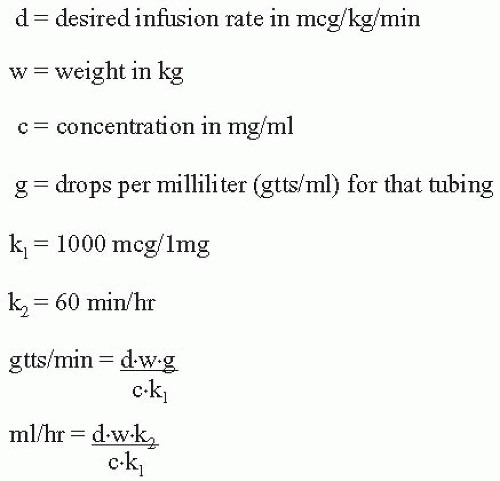Infusion Pumps: Great Technology When It Works
Stephen T. Robinson MD
Richard Botney MD
Infusion pumps are invaluable devices for delivering drugs and fluids at reliable and controlled rates. They are especially valuable for establishing stable blood levels of short-acting drugs. The three basic infusion delivery methods are gravity, peristalsis or metered delivery, and piston (syringe pump).
GRAVITY
Before infusion devices were widely used, infusion rates were regulated manually, and the rate was estimated by counting drops (gtts) in the intravenous (IV) drip chamber (Fig. 94.1). Adjustments were made by moving the roller ball on the IV tubing. Typical chambers delivered an estimated 10 to 60 gtts/ml. Depending on the chamber design, 10 to 60 gtts/min were required to deliver 60 ml/hr. Although manual regulation is still used for simple IV fluid infusions, it is generally not appropriate for most drug administration unless there is a wide tolerance for error, close user observation and regulation, or an emergency situation.
Relying on gravity poses many challenges. No alarms or other safety features alert the user of problems or prevent errors in flow rate. Since the flow rate depends on gravity and on the patency of the IV line, the flow rate may change as the hydrostatic pressure from the bag decreases as the fluid is consumed. IV bags commonly empty unnoticed, requiring flushing of air from the IV line before continuation of infusion. Adjusting the wrong line can cause delivery of an inadequate amount of drug or cause inadvertent delivery of a bolus of a high-risk medication, such as potassium, with disastrous results. Labeling each line near the regulator and taping the roller ball may help reduce this risk.
Gravity devices are essentially manual systems that use a calibrated constrictor on the IV tubing. Using these devices, when they are working as intended, provides a more reliable infusion rate than does using the roller ball. Using gravity devices also reduces the risk for inadvertent delivery of a bolus of drugs, but poses the same risks as do standard gravity setups for obstruction and reduced delivery. In short, gravity devices are easy to set up and simple to use, but require close user monitoring.
EARLY ELECTRONIC INFUSION DEVICES
There were many early infusion devices, all of them crude by today’s standards and prone to substantial errors. One early device counted drops and adjusted the flow to match the desired count per minute. It was critical that the operator knew the volume/gtt. Converting the desired dose to the corresponding rate was a nontrivial exercise. If the sensor was partially dislodged, the device was prone to administer a large bolus because of the faulty feedback. Another device used special tubing that was tightly wound around three occluding rollers. Based on the bore of the selected tubing and the revolutions per minute of the device, one could estimate the delivery rate from a table provided by the manufacturer. Different models had different rate profiles. Of course, the wrong tubing or confusion of units (for instance, ml/min vs. ml/hr) posed some threat to the patient. Both of these systems could deliver wide-open flow when disconnected from the device without first manually occluding the IV tubing.
Stay updated, free articles. Join our Telegram channel

Full access? Get Clinical Tree




